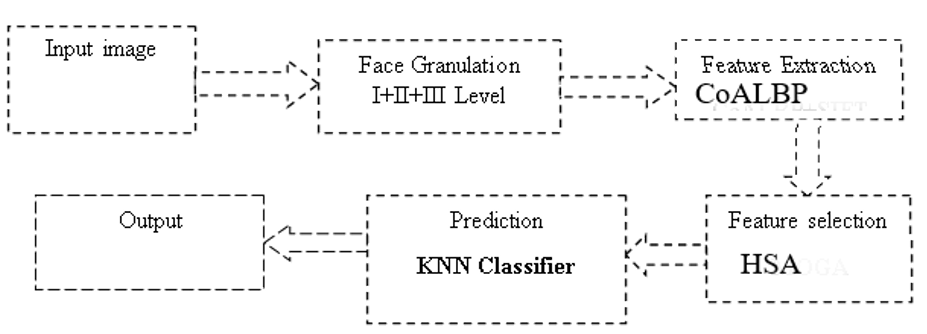Intelligent System for Face Recognition on Medically Altered Surgical Images using Machine Learning Algorithms
Keywords:
Face Reconstruction, plastic surgery, granular computing, Extended Uniform Circular Local Binary Pattern, Harmony Search Algorithm and KNNAbstract
Over the last two decades, there has been a significant increase in the number of plastic surgery procedures performed on the face, ranging from minimally invasive treatments to more extensive surgeries. This trend, which carries social and cultural significance, is expected to continue growing as the cost of these procedures decreases and the desire for physical enhancement becomes more widespread. Consequently, the field of face recognition research faces a new challenge: developing methods that can accurately identify individuals even if their appearance has been altered through facial surgery. Despite previous efforts to overcome challenges such as variations in pose, expression, illumination, aging, and disguise, the rise in plastic surgery necessitates further advancements in this area. While plastic surgery is viewed as a challenging topic of study, there has been little theoretical or experimental research conducted on the subject. The objective of this article is to examine the impact of plastic surgery on facial recognition algorithms. In this paper, the performance of face reconstruction is performed Extended Uniform Circular Local Binary Pattern (EUCLBP), Harmony Search Algorithm and KNN classifier. An open dataset of 1800 before and after images from 900 human faces undergoing plastic surgery was used to test all algorithms. Each individual had two front-facing images taken with appropriate lighting and neutral expressions - one before surgery and one after. The results consistently demonstrated better performance and higher accuracy in identification compared to the current algorithm.
Downloads
References
Boutros, F., Damer, N., Kirchbuchner, F. and Kuijper, A., (2022). Self-restrained triplet loss for accurate masked face recognition. Pattern Recognition, 124, p.108473.
Yan, C., Meng, L., Li, L., Zhang, J., Wang, Z., Yin, J., Zhang, J., Sun, Y. and Zheng, B., (2022). Age-invariant face recognition by multi-feature fusionand decomposition with self-attention. ACM Transactions on Multimedia Computing, Communications, and Applications (TOMM), 18(1s), pp.1-18.
Vu, H.N., Nguyen, M.H. and Pham, C., (2022). Masked face recognition with convolutional neural networks and local binary patterns. Applied Intelligence, 52(5), pp.5497-5512.
Khedgaonkar, R., Raghuwanshi, M.M. and Singh, K.R., (2018), December. Patch-based face recognition under plastic surgery. In 2018 First International Conference on Secure Cyber Computing and Communication (ICSCCC) (pp. 364-368). IEEE.
Bamber, S. S. . (2023). Evaluating Performance of Beacon Enabled 802.15.4 Network with Different Bit Error Rate and Power Models. International Journal on Recent and Innovation Trends in Computing and Communication, 11(2s), 167–178. https://doi.org/10.17762/ijritcc.v11i2s.6040
Anwarul, S. and Dahiya, S., (2020). A comprehensive review on face recognition methods and factors affecting facial recognition accuracy. Proceedings of ICRIC 2019: Recent Innovations in Computing, pp.495-514.
Singh, R., Agarwal, A., Singh, M., Nagpal, S. and Vatsa, M., (2020), April. On the robustness of face recognition algorithms against attacks and bias. In Proceedings of the AAAI Conference on Artificial Intelligence (Vol. 34, No. 09, pp. 13583-13589).
Moreano, J.A.C. and Palomino, N.B.L.S., (2020). Global facial recognition using gabor wavelet, support vector machines and 3d face models. Journal of Advances in Information Technology, 11(3).
Mr. Dharmesh Dhabliya, Ms. Ritika Dhabalia. (2014). Object Detection and Sorting using IoT. International Journal of New Practices in Management and Engineering, 3(04), 01 - 04. Retrieved from http://ijnpme.org/index.php/IJNPME/article/view/31
Lin, K., Zhao, H., Lv, J., Li, C., Liu, X., Chen, R. and Zhao, R., (2020). Face detection and segmentation based on improved mask R-CNN. Discrete dynamics in nature and society, 2020, pp.1-11.
Rathgeb, C., Satnoianu, C.I., Haryanto, N.E., Bernardo, K. and Busch, C., (2020). Differential detection of facial retouching: A multi-biometric approach. IEEE Access, 8, pp.106373-106385.
Zong, X., (2018). Local Binary Patterns Based on Subspace Representation of Image Patch for Face Recognition. In Structural, Syntactic, and Statistical Pattern Recognition: Joint IAPR International Workshop, S+ SSPR 2018, Beijing, China, August 17–19, 2018, Proceedings 9 (pp. 130-139). Springer International Publishing.
Gupta, S., Thakur, K. and Kumar, M., (2021). 2D-human face recognition using SIFT and SURF descriptors of face’s feature regions. The Visual Computer, 37, pp.447-456.
Zhi, H. and Liu, S., (2019). Face recognition based on genetic algorithm. Journal of Visual Communication and Image Representation, 58, pp.495-502.
Abuzneid, M.A. and Mahmood, A., (2018). Enhanced human face recognition using LBPH descriptor, multi-KNN, and back-propagation neural network. IEEE access, 6, pp.20641-20651.
Mr. Kaustubh Patil, Promod Kakade. (2014). Self-Sustained Debacle Repression Using Zig-Bee Communication. International Journal of New Practices in Management and Engineering, 3(04), 05 - 10. Retrieved from http://ijnpme.org/index.php/IJNPME/article/view/32
Hussein, M.M., Mutlag, A.H. and Shareef, H., (2020), February. An improved artificial neural network design for face recognition utilizing harmony search algorithm. In IOP Conference Series: Materials Science and Engineering (Vol. 745, No. 1, p. 012038). IOP Publishing.
Aik, L.E., Hong, T.W. and Junoh, A.K., (2019). An improved radial basis function networks in networks weights adjustment for training real-world nonlinear datasets. IAES International Journal of Artificial Intelligence, 8(1), pp.63-76.

Downloads
Published
How to Cite
Issue
Section
License

This work is licensed under a Creative Commons Attribution-ShareAlike 4.0 International License.
All papers should be submitted electronically. All submitted manuscripts must be original work that is not under submission at another journal or under consideration for publication in another form, such as a monograph or chapter of a book. Authors of submitted papers are obligated not to submit their paper for publication elsewhere until an editorial decision is rendered on their submission. Further, authors of accepted papers are prohibited from publishing the results in other publications that appear before the paper is published in the Journal unless they receive approval for doing so from the Editor-In-Chief.
IJISAE open access articles are licensed under a Creative Commons Attribution-ShareAlike 4.0 International License. This license lets the audience to give appropriate credit, provide a link to the license, and indicate if changes were made and if they remix, transform, or build upon the material, they must distribute contributions under the same license as the original.





